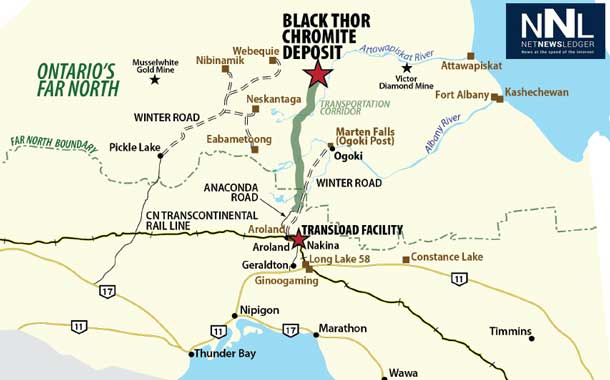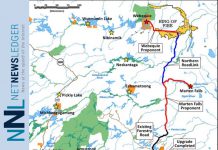 TORONTO – MINING – Red Pine Exploration Inc. has announced the results from its 2014 Cayenne Property drilling program, located 110 kilometres southwest of Timmins, Ontario. Mechanized trenching is underway and the Company is currently mobilizing for its planned spring drill program of 15-20 holes totalling about 3,000 metres which will commence early next week. Following a successful financing, the Company is now well positioned for the 2014 exploration year as this allows for approximately another 18,000 metres of drilling to be completed without any additional external financing.
TORONTO – MINING – Red Pine Exploration Inc. has announced the results from its 2014 Cayenne Property drilling program, located 110 kilometres southwest of Timmins, Ontario. Mechanized trenching is underway and the Company is currently mobilizing for its planned spring drill program of 15-20 holes totalling about 3,000 metres which will commence early next week. Following a successful financing, the Company is now well positioned for the 2014 exploration year as this allows for approximately another 18,000 metres of drilling to be completed without any additional external financing.
Drilling identified an extension at depth of the Jefferson deposit with a geologic horizon (the “Jefferson Horizon”) that is the main host of the volcanogenic massive sulfide mineralization (“VMS”). Also, a new VMS centre was discovered 2.5 kilometres west of Red Pine’s VenCan Showing with pervasive copper enrichment.
A total of 10 exploration holes (CC14-04 to CC14-13) were drilled in January-February, 2014. Exploration efforts to date have identified several mineralized centres across a 5 kilometre strike length at Cayenne – pointing to a potential VMS camp. The winter 2014 drilling program continued to explore along the extensive strike length of the Mattabi-type volcanogenic massive sulphide (VMS) system. Red Pine is targeting a potential VMS discovery in excess of 5 million tonnes, which would be located close to extensive existing infrastructure.
Jefferson Deposit
Drilling identified extensions of the Jefferson deposit both laterally and at depth. Stratigraphic and structural evidence indicates that the high grade massive sulfide zones of the Jefferson Deposit are “pockets” of initially larger polymetallic massive sulfide bodies. Each pocket is surrounded by stockwork material or thinner massive sulfide zones. The potential, but also the continuity of VMS mineralization in the Jefferson deposit, is evidenced by Hole CC14-05 that intersected a 30 metre long and continuous zone of semi-massive to disseminated VMS zinc-copper-lead (“Zn-Cu-Pb”) mineralization. This hole extends the Jefferson Deposit mineralization along the same stratigraphic horizon (“Jefferson Horizon”) and shows the potential to find a new zone of high grade massive sulfide mineralization either deeper or laterally along strike.
Table 1: Assay highlights – Jefferson Deposit
|
Borehole |
Silver (Ag) g/t |
Copper(Cu) |
Lead (Pb) |
Zinc |
From (m) |
To (m) |
Length* (m) |
|
|
CC14-05 |
5.88 |
0.16 |
1.18 |
2.29 |
68.20 |
101.25 |
33.05 |
|
|
Including |
3.68 |
0.03 |
1.48 |
4.57 |
69.20 |
74.20 |
5.00 |
|
|
Including |
21.82 |
0.75 |
3.38 |
4.44 |
89.10 |
95.25 |
6.15 |
|
|
CC14-06 |
0.58 |
0.02 |
0.65 |
2.10 |
14.00 |
20.00 |
6.00 |
|
|
CC14-07 |
0.11 |
0.66 |
0.00 |
0.27 |
1.64 |
31.50 |
35.50 |
|
|
CC14-13 |
0.49 |
0.01 |
0.06 |
0.20 |
14.75 |
50.00 |
35.25 |
|
|
|
Including |
2.67 |
0.03 |
0.13 |
0.85 |
17.75 |
20.75 |
3.00 |
|
|
Including |
0.91 |
0.03 |
0.28 |
0.82 |
46.50 |
50.00 |
3.50 |
* Lengths reported above in metres (“m”) are drill intersected core and do not represent true widths.
Drilling planned in this area will focus on expanding the Jefferson Horizon to the east, west and north (the new exhalative horizon1 ).
Vencan Zinc Showing
Holes CC14-10 and CC14-12 confirmed the along strike western extension of the VMS mineralization initially intersected in hole CC14-01 (27.47 metres of 9.36% zinc including 12.71 metres of 16.51% zinc). The intersected semi-massive to disseminated Zn mineralization in both holes is typical of stockwork material found stratigraphically below the massive sulfide lenses in the Vencan area. Based on its chemistry and pervasive base metal enrichments, the stockwork material intersected in holes CC14-10 and CC14-12 represents a strong proximity indicator of polymetallic VMS massive sulfide lenses.
Table 2: Assay highlights – Vencan Showing
| Borehole |
Silver |
Copper (Cu) |
Lead |
Zinc |
From (m) |
To (m) |
Length* (m) |
|
CC14-10 |
3.21 |
0.12 |
0.42 |
3.13 |
55.00 |
59.00 |
4.00 |
|
CC14-12 |
1.17 |
0.02 |
0.15 |
0.60 |
61.00 |
68.00 |
7.00 |
* Lengths reported above in metres (“m”) are drill intersected core and do not represent true widths.
Table 3: Silver (Ag) assay highlights – Vencan Showing
| Borehole |
Silver |
From (m) |
To (m) |
Length* (m) |
| CC13-01 |
9.48 |
11 |
38.7 |
27.47 |
| including |
16.26 |
23.54 |
36.25 |
12.71 |
| CC13-02 |
3.58 |
2.26 |
18.7 |
16.44 |
| including |
9.58 |
2.26 |
6.98 |
4.34 |
* Lengths reported above in metres (“m”) are drill intersected core and do not represent true widths.
Geochemical, structural and geophysical analysis point to a target beneath the existing drilling intersections at Vencan. This is typical of a boudinaged system – mineralized lenses which “pinch and swell” along the entire strike length. Drilling at Vencan will focus on locating the “swelled” zones as they would contain the largest volumes of potential mineralization.
A complete table of all assays will be available on our website.
1Iron-rich exhalites, formed by sub-seafloor hydrothermal activity, are prospective of VMS mineralization and are a useful vector to ore according to J.M. Franklin, PhD, FRSC, PGeo.
About the Cayenne-Chili Property
- The Cayenne Property hosts a Mattabi-type VMS System Associated with an adjacent iron rich exhalative horizons (multiple)
- The multiple lenses of mineralization observed in the VenCan showings and Jefferson deposit indicate a stacked sequence of mineralized horizons
- Known high grade mineralization – assayed values of up to 24.7% zinc, 15.6% lead and 1.1% copper from grab samples along the corridor (2013)
- Close to existing infrastructure (rail line, power, all weather roads)





